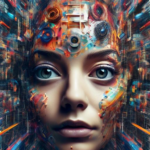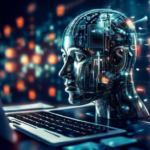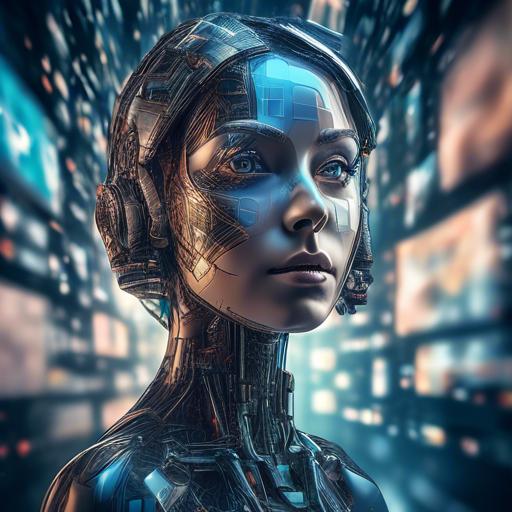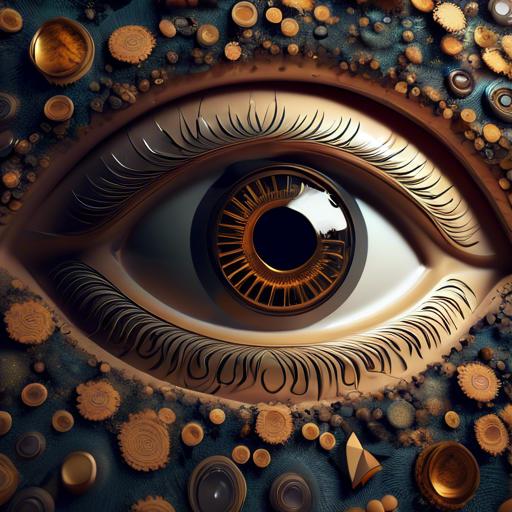In a world where visual storytelling reigns supreme, the marriage of artificial intelligence and stock photography is nothing short of a renaissance. Envision a place where creative visions are no longer bound by the limitations of time, distance, or even reality itself. Here, algorithms serve as both muse and master, conjuring images that perfectly capture the essence of your imagination. The dusty archives of yesterday’s stock photos are giving way to an age where the only limit is the creativity of the human mind, amplified by the computational wizardry of AI. Welcome to the new frontier where pixels meet potential, and the world of stock photography undergoes a breathtaking transformation. Join us as we delve into this exciting evolution, and celebrate the ways AI is reshaping the landscape, one image at a time.
Table of Contents
- Demystifying AIs Impact on Stock Photography
- Harnessing Machine Learning for High-Quality Image Generation
- Streamlining Image Searches with Advanced Algorithms
- The Role of AI in Enhancing Photo Metadata
- Ethical Considerations in AI-Driven Stock Photography
- How AI Tools Empower Photographers and Designers
- MITIGATING Bias in AI-Generated Visual Content
- Future Trends: AIs Next Steps in Visual Arts
- Insights and Conclusions
Demystifying AIs Impact on Stock Photography
As emerging technologies continually redefine industries, stock photography hasn’t been spared from transformation.
**Artificial Intelligence (AI)** is playing a monumental role in reshaping this domain, bringing a wave of opportunities and challenges alike.
Traditional methods of curation and selection are now being augmented by intelligent systems capable of nuanced analysis.
**Here are some key ways AI is making its mark**:
- Automated Tagging and Metadata: AI algorithms can efficiently tag photos with relevant keywords, making searchability a breeze. No more endless scrolling!
- Enhanced Image Quality: From color corrections to noise reduction, AI tools enhance image quality swiftly and effectively, bringing out the best in every shot.
- Personalized Recommendations: Using user data and preferences, AI systems can recommend photos that closely match your needs, offering a layer of personalization never seen before.
Additionally, **AI is impacting the stock photography ecosystem in deeper, more analytical ways**. Algorithms can analyze trends and predict the types of images that are likely to be in demand. For example, if there’s a spike in searches for eco-friendly themes, the AI can prompt photographers to focus on these subjects.
| Aspect | Traditional Methods | With AI |
|---|---|---|
| Tagging | Manual, time-consuming | Automated, efficient |
| Quality Enhancement | Manual editing | AI-driven optimization |
| Search & Recommendations | Basic filtering | Personalized suggestions |
AI is championing inclusivity in stock photography by identifying and filling gaps in representation. Traditionally underrepresented groups and themes are now getting the spotlight they deserve, creating a more diverse and comprehensive portfolio of images available to users.
Harnessing Machine Learning for High-Quality Image Generation
The ability of **machine learning** to create high-quality images indistinguishable from those taken by professional photographers is nothing short of revolutionary. These algorithms analyze millions of photos, learning the intricacies of color, composition, and detail. Here are some of the primary ways in which AI is transforming stock photography:
- Personalized Imagery: Brands can now generate images tailored precisely to their marketing needs, ensuring relevance and engagement with their target audiences.
- Cost Efficiency: With AI, high-quality images are more accessible and affordable, reducing the need for expensive photo shoots and model coordination.
- Creative Freedom: Machine learning allows photographers and artists to explore new realms of creativity by easily modifying or combining different visual elements.
The core of this transformation lies in **Generative Adversarial Networks (GANs)**, a type of machine learning model that pits two neural networks against each other to produce stunningly realistic images. This technology listens to the data, learns the nuances from countless photographs, and offers outputs that are not only lifelike but also unique. One common application is generating authentic-looking human faces, which can be used for various media requirements without the complications of model releases.
| Traditional Stock Photography | AI-Generated Photography |
|---|---|
| High production costs | Lower production costs |
| Limited personalization | Highly customizable |
| Time-consuming | Instant generation |
**Stock domain** landscapes or abstract art, to **specific demands** like futuristic cityscapes or customized product backgrounds, AI-generated images are rich in detail and authenticity. This enables businesses to stay ahead of trends with fresh, engaging visuals instantly. The era of scouring stock photo libraries for the perfect image may soon be behind us as AI continues to evolve and embed itself deeper into creative processes.
Streamlining Image Searches with Advanced Algorithms
Searching for the perfect image in the vast sea of stock photography can often feel like looking for a needle in a haystack. However, the advent of advanced algorithms has dramatically transformed this experience. **AI-powered image search** now offers a more intuitive, efficient, and personalized approach to finding the ideal visual content for your projects.
AI-based solutions utilize technologies such as **computer vision**, **machine learning**, and **natural language processing** to better understand and categorize images. This not only enhances the speed of searches but also improves the accuracy of results. Imagine typing a vague description into a search bar and instantly receiving relevant, high-quality images that match your criteria perfectly.
- Tag Generation: Automated tags based on object recognition and scene analysis.
- Similarity Matching: Find images visually similar to a reference photo.
- Contextual Understanding: Search results that understand and align with user intent.
- Enhanced Personalization: Tailored image suggestions based on user behavior and preferences.
Moreover, these algorithms are continually learning and evolving. Utilizing datasets from diverse image databases, AI refines its understanding of visual aesthetics, cultural contexts, and even emerging trends. This makes it possible to anticipate and meet the needs of a dynamic user base more effectively.
| Feature | Benefit |
|---|---|
| Automated Tagging | Reduces manual effort and increases search accuracy. |
| Visual Similarity Search | Finds visually consistent images easily. |
| Real-time Learning | Adapts to latest trends and user preferences. |
The implications of these advancements are profound for content creators and businesses alike. By streamlining the image search process, AI not only saves valuable time but also enhances creativity and productivity. Imagine having more time to focus on crafting compelling narratives, while AI handles the intricacies of finding the best visuals to complement your work.
The Role of AI in Enhancing Photo Metadata
Artificial Intelligence is transforming the way photographers and stock photo websites manage their vast collections of images. By automating metadata generation, AI frees up valuable time, allowing photographers to focus on their creativity. AI algorithms are adept at recognizing and categorizing elements within an image, making it easier than ever to organize photo libraries and improve searchability.
One of the most impactful features is **object recognition**. AI can identify objects, people, scenes, and even emotions in photographs, adding relevant metadata tags automatically. This differs significantly from previous manual methods, where tagging each image individually was tedious and time-consuming. AI can quickly analyze thousands of photos, ensuring that each one is accurately described and easily located.
- Improved Search Results: Enhanced metadata leads to more relevant search results, increasing the likelihood that users will find exactly what they need.
- Automated Descriptions: AI-generated captions and descriptions save time and provide consistency across image collections.
- Better Organization: Enhanced metadata makes it easier to categorize and sub-categorize images, ensuring a more organized library.
AI doesn’t just add value through metadata; it also offers **smart filters** and **suggestions**. For instance, if a stock photo website frequently receives searches for “beach sunset,” AI can suggest similar photos with related tags, ensuring users never miss a relevant image. Moreover, AI can customize these suggestions based on user behavior, providing a personalized experience.
| Feature | Benefit |
|---|---|
| Object Recognition | Accurate and automatic tagging of elements |
| Smart Filters | Enhanced searchability and user experience |
| Automated Descriptions | Consistent and time-efficient metadata creation |
By leveraging these AI-driven advancements, stock photography platforms can significantly boost their operational efficiency and enhance user satisfaction. This revolution not only streamlines the management of vast photo libraries but also opens up new avenues for photographers to showcase their work more effectively.
Ethical Considerations in AI-Driven Stock Photography
As AI continues to shape the landscape of stock photography, it brings with it a host of ethical considerations that must be addressed. One major concern is the potential for **bias in AI algorithms**, which could inadvertently promote stereotypes or exclude certain groups from representation. For instance, AI models trained predominantly on images of specific demographics might fail to recognize or generate accurate information for others. This highlights the importance of diversifying training datasets and ensuring they encompass a broad spectrum of human experiences.
Another significant issue is the matter of **intellectual property and copyright**. AI-generated images blur the lines of ownership, raising questions about who holds the rights to these creations. Traditional models attribute ownership to the creator, but in the case of AI, is it the developer, the platform, or the end-user? Addressing this ambiguity is crucial to safeguard the rights of photographers and ensure fair compensation.
The potential for **deepfakes and misinformation** is a growing concern linked to AI-generated imagery. High-quality, photorealistic images created by AI can be exploited to deceive or manipulate public opinion. Ensuring the integrity of visual content and fostering trust among consumers is imperative. Implementing strict guidelines and developing detection tools to identify and flag fraudulent images can help mitigate this risk.
While addressing ethical dilemmas, it’s essential to recognize the advantages AI brings to stock photography. It can democratize access to high-quality visuals, making them available to small businesses and individual creators who might not have the resources to commission bespoke photography. Additionally, **AI can help identify trends and preferences**, tailoring image suggestions to enhance user experience and satisfaction.
Balancing the benefits with the challenges requires a proactive approach, involving continuous dialogue among developers, users, and policymakers. Setting industry standards and encouraging transparency in AI processes can pave the way for a more ethical and inclusive future in stock photography.
How AI Tools Empower Photographers and Designers
Artificial Intelligence (AI) tools are transforming the creative landscape, offering photographers and designers new levels of efficiency and innovation. At the intersection of technology and artistry, AI enhances creative processes, making it easier to produce stunning visuals and manage vast stock libraries.
For photographers, AI simplifies the workflow in various ways:
- Image Enhancement: Automated tools for color correction, exposure balancing, and noise reduction can augment photo quality without exhaustive manual tweaking.
- Subject Recognition: Intelligent algorithms can detect and isolate subjects from backgrounds, facilitating more seamless edits and composites.
- Content Analysis: By assessing image content and style, AI can suggest optimal keywords and tags, improving searchability in stock image libraries.
Designers also reap the benefits of AI-driven tools:
- Auto-Design: AI engines can quickly generate layouts and templates, offering a base for customization and creative exploration.
- Pattern Recognition: Advanced systems recognize trends and suggest designs that align with current aesthetics, ensuring relevance in the market.
- Resource Management: By efficiently organizing and categorizing assets, designers can maintain a streamlined workflow and easily access critical resources.
The integration of AI into stock photography’s ecosystem is also evident in smarter search functionalities. Advanced AI algorithms can interpret complex queries and provide highly relevant results based on context rather than just keywords. This elevates the search experience, making it simpler to discover unique and specific images.
Moreover, AI’s influence extends to predictive analytics, optimizing stock photo selection by highlighting images trending within specific industries or demographics. This makes it easier for creatives to stay ahead of the curve and cater to ever-changing market demands.
| Feature | Benefit |
|---|---|
| Auto-Tagging | Improves searchability |
| Image Enhancement | Boosts photo quality |
| Content Analysis | Optimizes keywording |
MITIGATING Bias in AI-Generated Visual Content
As artificial intelligence transforms the landscape of stock photography, it’s critical to address the potential for biases that could inadvertently creep into AI-generated visual content. These biases can originate from several sources, including the training data, model architecture, or even unconscious human prejudices. To create truly inclusive and diverse imagery, we must adopt methods that proactively mitigate these biases.
One effective strategy is the curation of **diverse training datasets**. By ensuring that the datasets used to train AI models encompass a broad spectrum of ethnicities, cultures, genders, and age groups, we can significantly reduce the risk of AI perpetuating stereotypes. This involves:
- Including images from various geographies.
- Representing different social and economic backgrounds.
- Incorporating a balanced mix of professional, casual, and traditional attire.
Another approach is to embed **bias-detection algorithms** within the AI framework itself. These algorithms can scan and flag potentially biased outputs, offering a critical checkpoint before images reach a public platform. Implementing such measures empowers content creators to preemptively address issues of representation and fairness.
Collaborative oversight is also a vital component. Engaging a diverse group of reviewers to inspect AI-generated visuals can bring multiple perspectives into the evaluation process, ensuring the imagery aligns with contemporary societal values. This collective intelligence can catch nuanced biases that a single developer might overlook.
| Aspect | Importance | Mitigation Strategy |
|---|---|---|
| Diverse Representation | High | Curate Inclusive Datasets |
| Bias Detection | Medium | Embed Scanning Algorithms |
| Oversight | High | Diverse Group Review |
Future Trends: AIs Next Steps in Visual Arts
Artificial Intelligence (AI) has radically transformed the landscape of visual arts, particularly in the realm of stock photography. Visual content creation is no longer confined to the human eye and hand; enriched algorithms now play a critical role in generating, categorizing, and enhancing stock images. This alliance between tech and artistry is poised to redefine several aspects of the industry.
Automated Image Generation
One of the most significant advancements is AI’s capability to generate high-quality stock images autonomously. Techniques like **Generative Adversarial Networks (GANs)** enable the creation of hyper-realistic images from scratch. The results are often indistinguishable from those taken by professional photographers, empowering artists to produce limitless variations without the constraints of traditional photography.
- Customizable backgrounds and scenes
- Instant adjustments for color, lighting, and composition
- Reduction in production costs and time
Intelligent Image Analysis
AI enhances not just the creation, but also the curation of stock photography. Deep learning algorithms analyze visual content to categorize and tag images with unprecedented accuracy. This streamlining makes it easier for users to find exactly what they need, contributing significantly to user experience and satisfaction.
| Feature | Benefit |
|---|---|
| Object Recognition | Identifies and tags multiple elements |
| Content Filtering | Eliminates inappropriate images |
| Image Similarity | Finds visually similar photos |
Enhanced User Personalization
AI-driven user personalization adds another layer to the innovation in stock photography. By analyzing user behavior and preferences, AI systems can recommend tailored content, creating a seamless and more personalized browsing experience. Over time, this will help both users and creators to engage more deeply and frequently.
- Personalized search results based on user history
- Adaptive content that changes based on user feedback
- Enhanced engagement through relevant recommendations
Insights and Conclusions
it is clear that AI is making remarkable strides in revolutionizing stock photography. With its ability to streamline the image search process, improve image quality and recognize patterns, AI is proving to be a valuable tool for photographers and businesses alike. As technology continues to advance, we can only expect AI to further enhance and innovate the world of stock photography. Embracing this technological advancement will undoubtedly lead to a more efficient and exciting future for the industry. So, let’s welcome AI with open arms and watch as it continues to transform and elevate the world of stock photography. The possibilities are truly endless!
































